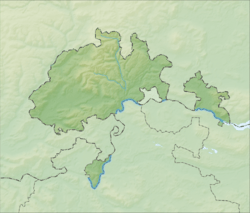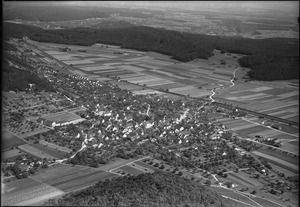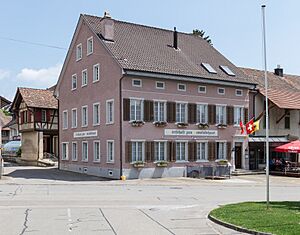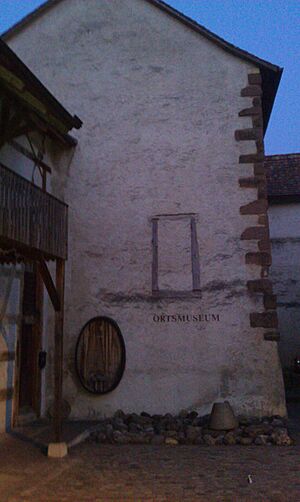Beringen, Switzerland facts for kids
Quick facts for kids
Beringen
|
||
|---|---|---|
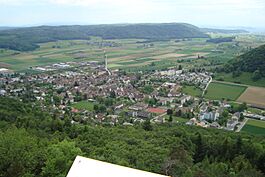 |
||
|
||
| Country | Switzerland | |
| Canton | Schaffhausen | |
| District | n.a. | |
| Area | ||
| • Total | 18.68 km2 (7.21 sq mi) | |
| Elevation | 456 m (1,496 ft) | |
| Population
(Dec 2020 )
|
||
| • Total | 5,044 | |
| • Density | 270.02/km2 (699.35/sq mi) | |
| Postal code |
8222
|
|
| Surrounded by | Hemmental, Löhningen, Neuhausen am Rheinfall, Schaffhausen, Siblingen | |
Beringen is a cool town in Switzerland. It's located in the canton of Schaffhausen. Think of a canton like a state or a large region. On January 1, 2013, another nearby town called Guntmadingen joined with Beringen, making it a bit bigger!
Contents
History of Beringen
The story of Beringen, and Switzerland, goes way back to the Ice Age and Stone Age. But the real story starts around 800–58 B.C. with the Helvetii. They were a Celtic tribe who gave their name to Switzerland. That's why you see "HELVETIA" on Swiss flags, coins, and stamps!
Life in the Bronze Age
Imagine finding a treasure from thousands of years ago! In the Eschheimer Valley near Beringen, people found an ancient burial site. It's thought to be from the early Bronze Age. Deep underground, they discovered a skeleton with a bronze axe, a dagger, a fancy needle, and some bronze nails. This shows us how people were buried a very long time ago.
The Roman Times
Did you know Romans lived in Beringen? There's good proof that a group of buildings in the Lieblosen-Valley dates back to when the Romans ruled this area. You can still see an old wall that was part of their living and working spaces.
The Romans took control of Switzerland around 58 B.C. They built military camps and forts along the Rhine River. A cool discovery was a special tile with the marks of the 11th and 21st Roman armies, plus a group of Roman volunteers. Similar tiles have been found right here in Beringen!
How Beringen Grew
Beringen grew up around a small creek that still runs through the village. This creek was super important! It powered mills, like a flour mill and a gypsum mill. It also provided water for dye-shops and was where people washed things. Animals drank from it, and it was the only way to fight fires!
The first people who settled here built their homes close to the creek, side by side. Over time, when a house burned down, they sometimes built a public building instead. This meant more families could get water. Famous old buildings like the Leunhof, which is now a restaurant, show how the village used to be.
Today, the creek in Beringen is mostly covered. We get water through pipes, and there are many modern buildings. You'll find fewer farms now, as Beringen has grown into a modern town.
Old Buildings and Their Stories
Beringen has many amazing old buildings that tell stories from the past:
- The Church of Beringen
We're not totally sure who the church's special saint is, but it might be Saint George! Records show a church here since at least 1231. It's been added to over the years, with a tower and clock added in 1645. New bells came in 1906, and an organ in 1911. People still enjoy seeing its tall steeple and sun clock today.
- The Parsonage of Beringen
This is the old home of the village priest. It's right across from the Huenen Castle and is still used by the church community. It's been fixed up many times. An old chestnut tree that used to stand there was taken down in 1955 when the street was changed.
- Castle of the Huenen Family (around 1200s)
The Huenen family were important people who built this castle in the 1200s. They kept making it bigger over the centuries! You can see drawings that show parts added in the 1200s, 1500s, 1600s, and even later.
Thanks to a special group, the castle was completely restored. Since 1989, it's been home to the Museum of Beringen! This museum shows historical items from Beringen and nearby villages, making it a popular place to visit.
- The Paradise-Estate (Monastery)
A monastery called "Paradice" wanted to own more land. In 1289, they bought several pieces of land in Beringen. They bought a big estate called "Kehlhof" in 1291, and another one called "The Bonstetten" in 1296.
This monastery was run by nuns, and they ended up owning a lot of land in Beringen. The houses built on these lands were later called "Paradieserhof."
- The MunggeHof
A "Hof" is a group of buildings, usually with a house, barn, and animal sheds. They were like small communities on their own! "Mungge" is a local word for "Monk." So, the Munggehof was likely owned by monks. Other Hofs like VogelHof and Chehlhof also show how monasteries once owned much of the land.
The Munggehof was important for the community. The yearly "Beringer-Chilbi," a folk festival, used to be held there. It had horse riding and stalls selling treats. Now, the festival is held in a bigger space called the Fire-Square.
- The VogelHof
The Vogelhof was one of the oldest parts of the village. The houses were built very close together, with roofs that stuck out to protect from rain and sun. Cellar entrances were at the front, and wide stairs led to the second floor.
"Vogel" was the name of a family who lived there. People who made barrels, furniture, and worked with stone had businesses here. The last members of the Vogel family passed away in 1978.
- The Lions Inn (before 1711)
In Switzerland, many old restaurants are named after animals like the Lion or the Eagle. Beringen's most famous restaurant was "The Lion." It was first mentioned in 1711. The owner had to put up a fancy iron sign with a lion on it.
The "Lion" was also the meeting place for the "Society of Boys" of Beringen. These groups have been around since the 1400s! The one in Beringen is the only one left in the whole Schaffhausen canton. The building is large and has a beautiful lion image on its front.
In 1845, a group for craftspeople and traders, called the "Gewerbeverein," started here. It was the first group of its kind in Beringen! The "Lion" stopped being a restaurant in the 1930s, but the building is still there, used for apartments and shops. The big lion sign was saved and is now in the new community center.
- The Old School House (around 1739)
The first school house was built in 1739. We don't have pictures of it, but it served the village for 85 years until it burned down in 1824. A new school was built in 1826. The first teacher, Hansjakob Huser, taught from 1608 to 1645!
Children from the nearby village of Neuhausen, especially older students, came to Beringen for school. Neuhausen was a small village back then and didn't have rooms for higher grades.
A third school house was built in 1949, but even that became too small as more students came!
- The Old Flour Mill (around 1536)
This mill building is hundreds of years old and is at the top end of the village. It was first mentioned in 1536 and belonged to the whole community. It was rented out to people every few years. The mill stopped working many years ago, but the building is still used as a home. Above the main door, there's a cool poem carved into the stone!
- The "Gipsmuehle" – The Gypsum Mill
This mill was owned by the Boll family for many generations. It had a huge water wheel, 18 feet high! Gypsum came from a nearby town and was brought by wagons pulled by six horses, and later by streetcars. The gypsum was burned in tall ovens, creating a lot of smoke. Then it was broken into small pieces and put into the mill.
When there was plenty of water, the mill ran all day and night! It stopped working because it was too old and expensive to fix. Now, apartment buildings stand where the mill once was.
- The "Old" Post House
Long ago, this building was a bakery, a restaurant, and a post office! Every night, a postal coach from a faraway town would arrive. The coachman would blow his horn so the postmaster would bring the mail bag out to the street, because the coach didn't even stop!
Mail collection started in 1846. In 1862, Beringen got an official post office. A telegraph was added in 1874. The post office moved to bigger buildings in 1946 and then to the new community center in 1976.
- Gemeindehaus Restaurant (Community House)
In 1862, a man named Johannes Schneider suggested building a big public hall for 300 people. He wanted it to be heated and have extra rooms. In return, he asked not to pay yearly fees for 20 years.
The village council agreed, but with some rules:
- They needed a guard's room.
- The council could use it to house soldiers.
- The council would help pay for lighting and heating.
- The building had to be finished in 1863.
Today, parts of this building have been changed into more dining areas, a bakery, a coffee shop, and a small garden restaurant.
- The Eagle-House
This impressive building was built in 1863. It was known for its large roof. It was similar to other buildings built when the first railroads were being constructed.
After more than 100 years, the Eagle-House was taken down in 1966 to make space for a supermarket. That supermarket, which people called the "shoebox" because it wasn't very pretty, was also torn down after only 23 years. Now, a shopping center is there.
- The Dalcher-Hueseli
The Dalcher-Huesli reminds us of the old farm-style buildings in Beringen. "Huesli" is a sweet way to say "small house." These houses usually had a barn with animal stalls on the first floor and an apartment for servants on the second. The owners lived behind the barn. Sadly, the last Dalcher-Huesli was taken down in 1964 to make way for a small shop and facilities for the public streetcar system.
Beringen's Timeline
Here are some important dates in Beringen's history:
- 58 B.C.: The Romans defeat the Helvetii tribe. Roman rule begins!
- Around A.D. 260: The Germanic Alemanni tribe destroys the city of Aventicum.
- Around A.D. 500: The Alemanni start settling in the area.
- A.D. 800: Charlemagne is crowned king. Switzerland becomes part of the Holy Roman Empire.
- 965 A.D.: Beringen is first mentioned in old writings, though the document might be from later.
- 1090 A.D.: Bartholdes de Berinin is a witness in a trade involving Beringen.
- 1102-1112 A.D.: A person named Chono de Beringen is mentioned in an old document.
- 1150 A.D.: Lutfridus and Guntherrus de Beringen are witnesses in a legal fight.
- 1568 A.D.: People start digging for ore (metal) on the Laufenberg mountain. This continued until 1850.
- 1835 A.D.: The first village council is elected.
- 1863 A.D.: The railway starts running! The first train went from Neuhausen to Waldshut on December 12, 1862.
- 1893 A.D.: Street lights are installed in Beringen.
- 1897 A.D.: Ballot boxes for voting are approved.
- 1905 A.D.: The public streetcar system begins.
- 1950 A.D.: Ewald Rahm opens a private history museum. The public water system connects with Neuhausen.
- 1962 A.D.: A factory for wrapping machines is built in Beringen.
- 1963 A.D.: A factory that builds cranes opens in Beringen.
- 1964 A.D.: A new public streetcar company starts.
- 1965 A.D.: Beringen celebrates its 100th Anniversary.
- 1967 A.D.: The Catholic Church on Schaffhausen-Street is dedicated.
- 1969 A.D.: The new municipal swimming pool opens.
- 1976 A.D.: The "Zelg" Village Center opens with new offices, a post office, bank, and fire department. Ewald Rahm gives his historical collection to the community.
- 1977 A.D.: The first International Festival of Beringen is held.
- 1979 A.D.: The village council buys the "Faerberwiesli" Nature Preserve.
- 1984 A.D.: The "Zimmerberg" multi-purpose center opens.
- 1990 A.D.: The new Co-op Center opens.
Old Families of Beringen
Many families have lived in Beringen for centuries. Here are some of the oldest and most well-known families, whose names were shown on an old coat of arms from 1957:
- Bolli
- Bollinger
- Hauser
- Hug
- Keller
- Lang
- Rohrbasser
- Roost
- Zimmler
- Schlatter
- Schneider
- Schwyn
- Tanner
- Wolf
- Zoller
The Bollinger family, sometimes called Bolliger, has roots in Switzerland going back to the 400s-600s A.D.! The name "Bollo" was a family name, and "ingen" meant "children" or "people." So, the Bollinger family were the "children of Bollo." Other names like Zähringer and Zollinger were formed in a similar way. The Bollinger family settled in different parts of Switzerland, including Beringen. The first official document about the Bollingers dates back to 1362.
Geography of Beringen
As of 2006, Beringen covers about 18.68 km2 (7.21 sq mi) of land. A big part of this land, about 59.8%, is covered by forests. About 28.6% is used for farming. The rest, about 11.3%, has buildings or roads, and a tiny bit (0.2%) is rivers or other natural areas.
Beringen is located in the Schaffhausen region. It's a long village at the bottom of the Randen mountains. Today, it's mostly a place with industries and businesses.
Getting Around
Beringen has two train stations: Beringen Badischer Bahnhof and Beringerfeld. This makes it easy to travel to and from the town!
People of Beringen
In 2008, Beringen had a population of 3,375 people. About 16.3% of them were from other countries. Many of these foreign residents were from Germany (39.3%), Italy (22.9%), and Serbia (12.6%). Over the last 10 years, the population has grown by about 11.2%.
Most people in Beringen (93.6%) speak German. Italian is the second most common language (1.9%), followed by Serbo-Croatian (1.0%).
When it comes to age, about 20.5% of the people are children and teenagers (0–19 years old). Adults (20–64 years old) make up 60.1%, and seniors (over 64 years old) are 19.3% of the population.
In the 2007 federal election, the most popular political party was the SVP, getting 38.6% of the votes. The SP and the FDP were also popular.
Most people in Switzerland are well-educated. In Beringen, about 81.2% of adults (aged 25–64) have finished high school or gone on to higher education like university. In 2007, about 1.99% of children were in kindergarten, 7.43% were in primary school, and others were in different levels of secondary school.
In 2000, about 23.3% of the people in Beringen were Catholic, and 58.1% belonged to the Swiss Reformed Church.
Here's how Beringen's population has changed over time:
| Year | Population |
|---|---|
| 1531 | 43 Households |
| 1771 | 702 |
| 1850 | 1,418 |
| 1900 | 1,208 |
| 1950 | 1,757 |
| 2000 | 3,027 |
| 2011 | 3,538 |
Jobs and Businesses
Beringen has a low unemployment rate of 1.27%. In 2005, there were 37 people working in farming and related businesses. A lot more people, 1,194, worked in manufacturing and construction. And 540 people worked in service jobs like shops and offices.
In 2008, about 69% of the working population was in manufacturing, and 31% was in service jobs. Most people (83.3%) worked full-time. Many people who live in Beringen also work in other towns, and many people from other towns come to Beringen for work.
Beringen also has 6 restaurants and 1 hotel with 51 beds, employing 32 people in the hospitality business.
See also
 In Spanish: Beringen (Suiza) para niños
In Spanish: Beringen (Suiza) para niños




